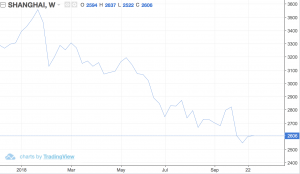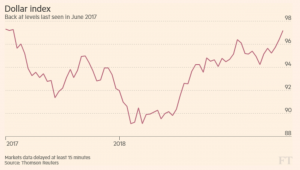October was the worst since 2012 for world stocks, one that casts doubt on the decade-long bull market for equities, according to the Financial Times, and by extension the fate of metal prices.
Although China’s CSI 300 closed up 1.4% this week, it was a bit of a dead cat bounce after a decline of 6% during the month, as this graph from Trading Economics shows:

Source: Trading Economics
The Chinese market has fallen from a peak of around 3,550 to 2,600 over the year. Most attribute the recent minor recovery to yet more promises of infrastructure investment made by Beijing.
But China is not alone seeing stock market volatility.
The Financial Times reports comments made by analysts from Capital Economics, who noted: “While upbeat earnings numbers have helped the US stock market find its feet again in the past couple of days, the bigger picture is that the S&P 500 has tumbled in recent weeks despite healthy earnings. We think that this reflects worries about the outlook for them, which in our view are likely to intensify as actual earnings growth slows sharply next year.”
Those fears seem to have abated for now on the back of stronger earnings results coming out both in the U.S. and Europe, and suggestions the Federal Reserve may not tighten quite so fast has taken the dollar off its highs.
The strong dollar has been depressing commodity prices this year, with a slight pullback this week taking it off a 16-month high hit on Wednesday, according to another Financial Times report.

Source: Financial Times
Despite strong fundamentals and producers facing considerable price pressure from rising alumina prices, aluminum has fallen along with other metals, in part due to the strong dollar.
On-warrant stocks of aluminum in LME-registered warehouses have fallen by 1,825 tons to 723,900 tons, but that only tells part of the tight supply market story.
The market deficit has been fed by off-warrant inventory finding its way back on the market. Off-warrant stocks held by the stock and finance trade have fallen from an estimated 10 million tons a few years ago to something closer to 3-4 million tons today. The very opacity of that market makes it very difficult to judge stock levels and, as a result, impossible to accurately estimate the true size of the aluminum market deficit if this supply source were not there.
What it does say is outside of China, aluminum’s medium-term fundamentals are strong. There are very few new smelters being built and limited return of idled capacity, even in the tariff-supported U.S.
Short-term price movements, however, are rarely driven by long-term fundamentals; the dollar and stock market sentiment will continue to exert volatility on the whole metals sector.
by Stuart Burns
